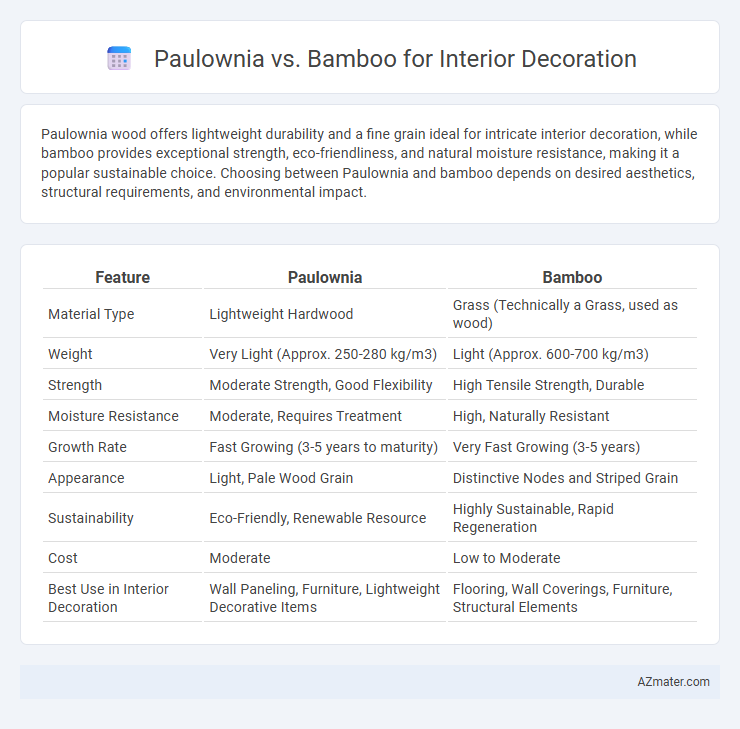Paulownia wood offers lightweight durability and a fine grain ideal for intricate interior decoration, while bamboo provides exceptional strength, eco-friendliness, and natural moisture resistance, making it a popular sustainable choice. Choosing between Paulownia and bamboo depends on desired aesthetics, structural requirements, and environmental impact.
Table of Comparison
| Feature | Paulownia | Bamboo |
|---|---|---|
| Material Type | Lightweight Hardwood | Grass (Technically a Grass, used as wood) |
| Weight | Very Light (Approx. 250-280 kg/m3) | Light (Approx. 600-700 kg/m3) |
| Strength | Moderate Strength, Good Flexibility | High Tensile Strength, Durable |
| Moisture Resistance | Moderate, Requires Treatment | High, Naturally Resistant |
| Growth Rate | Fast Growing (3-5 years to maturity) | Very Fast Growing (3-5 years) |
| Appearance | Light, Pale Wood Grain | Distinctive Nodes and Striped Grain |
| Sustainability | Eco-Friendly, Renewable Resource | Highly Sustainable, Rapid Regeneration |
| Cost | Moderate | Low to Moderate |
| Best Use in Interior Decoration | Wall Paneling, Furniture, Lightweight Decorative Items | Flooring, Wall Coverings, Furniture, Structural Elements |
Introduction to Paulownia and Bamboo in Interior Design
Paulownia wood is prized in interior decoration for its lightweight, fast growth, and smooth grain, offering a sustainable alternative with a pale, natural finish ideal for modern minimalistic designs. Bamboo, known for its strength, flexibility, and rapid renewable growth, provides a warm, textured aesthetic that suits contemporary and eco-friendly interiors. Both materials contribute to environmentally conscious design choices, with Paulownia emphasizing lightweight elegance and Bamboo delivering robust durability.
Material Properties: Paulownia vs Bamboo
Paulownia wood is lightweight, highly durable, and resistant to warping, making it ideal for interior decoration that requires stability and ease of handling. Bamboo, known for its rapid growth and exceptional strength-to-weight ratio, offers flexible and eco-friendly design options with notable tensile strength and resilience. Both materials provide sustainable alternatives, but Paulownia's fine grain and smooth texture contrast with Bamboo's fibrous composition, influencing their aesthetic and functional applications in interior spaces.
Sustainability and Eco-Friendliness Comparison
Paulownia wood offers exceptional sustainability due to its rapid growth rate, requiring minimal water and no pesticides, which reduces its environmental impact compared to bamboo that can sometimes involve intensive farming practices. Both materials are renewable, but Paulownia's lightweight nature and natural resistance to rot and insects make it an eco-friendly choice for long-lasting interior decoration. Bamboo remains a popular option for its strength and flexibility, yet Paulownia's carbon sequestration ability and lower resource demands provide a more sustainable alternative for environmentally conscious design.
Aesthetic Appeal: Wood Grain, Color, and Texture
Paulownia offers a light, warm hue with a fine, straight grain that creates a smooth, subtle texture ideal for minimalist and modern interior decoration. Bamboo features a distinctive linear grain and natural variations with a range of golden tones, adding a dynamic and organic texture that enhances eco-friendly design themes. Both materials provide unique aesthetic appeals, with Paulownia emphasizing softness and uniformity, while Bamboo delivers a bolder, more textured visual impact.
Durability and Longevity in Home Interiors
Paulownia wood offers remarkable durability with its resistance to warping and cracking, making it an ideal choice for long-lasting home interiors, especially in areas with fluctuating humidity. Bamboo, known for its tensile strength and flexibility, provides excellent wear resistance but may require treatment to enhance moisture durability in interior applications. Both materials excel in sustainability, yet Paulownia's natural dimensional stability often results in superior longevity compared to bamboo in interior decorative elements.
Versatility for Furniture and Decor Applications
Paulownia and bamboo offer distinct advantages in interior decoration, with paulownia prized for its lightweight yet strong timber, ideal for furniture requiring easy handling and intricate designs. Bamboo's fast growth and natural flexibility make it highly versatile for a wide range of decor applications, from flooring to wall panels and eco-friendly furniture. Both materials contribute sustainable options but paulownia's smooth finish suits refined aesthetic furniture, whereas bamboo excels in contemporary, durable decor elements.
Maintenance Requirements and Care Tips
Paulownia wood offers low maintenance with its natural resistance to warping and pests, requiring only occasional dusting and polishing to maintain its smooth finish. Bamboo, while durable, demands regular cleaning and protection from excessive moisture to prevent mold and swelling, making it essential to control indoor humidity levels. Both materials benefit from avoiding direct sunlight exposure to preserve color and structural integrity in interior decorations.
Cost-Effectiveness and Availability
Paulownia wood offers a lightweight and inexpensive option for interior decoration, with rapid growth rates ensuring steady availability and reducing long-term costs. Bamboo provides a highly renewable and durable material that remains competitively priced due to its widespread cultivation and quick harvest cycles. Both materials present cost-effective solutions, but bamboo's greater market presence often results in easier procurement for large-scale projects.
Popular Design Trends Featuring Paulownia and Bamboo
Paulownia and bamboo are increasingly popular in interior decoration due to their sustainability and aesthetic appeal. Paulownia's lightweight, smooth grain suits minimalist and Scandinavian design trends, while bamboo's strength and natural texture complement eco-friendly and Asian-inspired interiors. Both materials support biophilic design principles, promoting wellness through natural elements in living spaces.
Choosing the Right Material for Your Interior Style
Paulownia wood offers a lightweight, smooth texture with a pale hue, making it ideal for minimalist and Scandinavian interior styles that emphasize simplicity and natural light. Bamboo provides a more vibrant, textured appearance with strong durability and eco-friendly qualities, perfectly complementing tropical, rustic, or modern sustainable designs. Selecting between Paulownia and Bamboo hinges on desired aesthetics, durability needs, and the interior atmosphere you aim to create, with Paulownia suited for softer, airy spaces and Bamboo for robust, textured environments.

Infographic: Paulownia vs Bamboo for Interior Decoration
 azmater.com
azmater.com